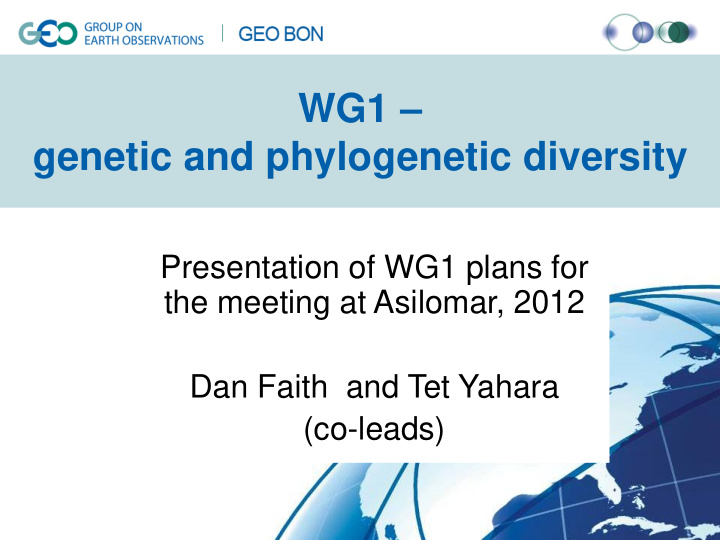



WG1 – genetic and phylogenetic diversity Presentation of WG1 plans for the meeting at Asilomar, 2012 Dan Faith and Tet Yahara (co-leads)
WG1 Candidate Deliverables • Genetic Diversity Report • Aichi target key species: genetic diversity indicators/EBVs • Plant diversity assessment (AP BON) • Genomic Observatories • Phylogenetic diversity standard indicators for change
Working group 1 Note – apologies from several invited WG1 members, who are linked to key deliverables • Kogure (note microbial diversity meeting) • Forest (note Linnean Soc symposium) • Billionnet • Bruford
First tasks based on discussions, complete pro-forma for each candidate deliverable
GEO BON Genetic Diversity Report • Within species genetic diversity – Review of global/regional changes (consensus paper in preparation – to be discussed here) – Illustrating some good examples (eg. GD loss in tropical rain forest, GD loss in crop-relatives, discuss others) – Building on March 2012 workshop, discuss plans for second scheduled workshop, with funding, for 2013. – Review and discuss synergies with WG1 Bruford lead deliverable on within-species genetic diversity indicators for AICHI targets; + Dulloo FAO/Bioversity
GEO BON Genetic Diversity Report • Phylogenetic diversity – Legume diversity as analysis/mapping case study – Review of published cases (mammals, birds etc) – Discuss progress and synergies with PD tools deliverable • Microbial diversity – Paper Illustrating some good examples (eg. invasion of Chytrid fungus of frogs, evolution of avian flu; plan here) – Review rapidly increasing data for environmental metagenomics; in anticipation of planned workshop in 2013 (Japan) – Discuss global maps of microbial diversity – Discuss links to PD spatial hierarchy models and WG7
AP BON plant diversity assessment – Database on states of plant species in candidate hotspots (“observatories”); species list, phylogenetic tree, trait matrix – Distribution maps (incl. modelled maps) of representative groups (Fabaceae, Fagaceae etc), including rare species – Red list of representative groups (Fabaceae, Fagaceae etc) – Task: review progress and links to other deliverables
Aichi target key species: genetic diversity indicators/EBVs AICHI 2020 targets Target 13: By 2020, the genetic diversity of cultivated Targets plants and farmed and domesticated animals and of wild relatives, including other socio-economically as well as culturally valuable species, is maintained, and strategies have been developed and implemented for minimizing genetic erosion and safeguarding their genetic diversity .
Aichi target key species: genetic diversity indicators/EBVs • EU Framework 7 Coordination and Support Action (Support) • project proposed by organizers of PGAC meetings Population Genetics for Animal Conservation) • 13 partners • End-user group • Focus on Science/policy interface for the genetic component of biodiversity
www.congressgenetics.eu The website goes ‘ officially live ’ on 1 st December 2012…
Three steps planned: 1. Literature review on what variables have been used during the last twenty years of Molecular Ecology 2. Theoretical analysis of which variables give the best combination of robustness and sensitivity 3. Synthesis of the two first aspects to come up with a minimal set of pragmatic variables that can be applied to existing data and to guide data collection between now and 2020 Intra specific genetic variation for wild and domestic species
Genomic Observatories A Genomic Observatory (GO) is a geographic site with a rich history of environmental/ecological data collection and a long-term commitment Following call for Genomic Observatories published: Nature (2012) and recent meeting of the Genomic Observatories Network, linked to GEO BON and WG1
Genomic Observatories - tasks Discuss GEO BON deliverables aspects Links to EBVs framework Funding proposal linking genomic observatories to monitoring and sustainability
Phylogenetic diversity standard indicators for change An outcome in part from last Asilomar meeting – PD now standard in macrobial and microbial studies But need PD-related change measures Review ACEAS exemplar, PD50 extended, indices implemented in e.g. Qiime
Phylogenetic diversity standard indicators for change WG1 member Alain Billionnet - recently developed powerful tool for looking at change in expected PD based on IUCN ratings costs or co-benefits Large trees, computationally efficient (overcomes weaknesses of standard EDGE)
Phylogenetic diversity standard indicators for change - tasks Product for GEO BON is framework and toolbox (e.g. in Qiime) for changes in PD (including. loss of spatial heterogeneity) paper for “ The year in evolutionary biology ” Discuss, evaluate methods and applicability within global legume assessment, etc
integration and coordination of activities among regional BONs (RBONs) - tasks Discuss cross-linkages between APBON WG1 and overall WG1 deliverables (noting recent meeting of APBON corresponding WG1) Do our deliverables integrate with those needed for EU BON?
integration and coordination of activities among working groups Build on WG1 member Alain Billionnet’s powerful tool for looking at change in Expected PD based on probabilities, plus costs or co- benefits, for large trees – Use this for hierarchical models of biodiversity Faith D P Biodiversity and evolutionary history: expanding the PD phylogenetic diversity assessment framework . Annals of the New York Academy of Sciences , "The Year in Evolutionary Biology".
integration and coordination of activities among working groups - Tasks (with links to WG7 etc) Discuss with other WGs: • EDGE (ecologically-distinctive, globally endangered) using ecosystems red list to assess expected biodiversity loss at species level Link to WG3 deliverable 2+ see http://australianmuseum.net.au/Ecosystems-on-the- EDGE-Ecologically-Distinctive-Globally-Endangered
integration and coordination of activities among working groups - Tasks (with links to WG7: Deliverable 1 “lens”) Discuss with WGs our planned extensions to : • Biodiversity change reports based on PD- dissimilarity models, - summarised as hierarchies of sites - using fractions of species, based on land condition/tenure (or partial protection - Faith (2012) Common ground for biodiversity and ecosystem services: the “partial protection” challenge. F1000 Research )
WG1 Candidate Deliverables • Genetic Diversity Report • Aichi target key species: genetic diversity indicators/EBVs • Plant diversity assessment (AP BON) • Genomic Observatories • Phylogenetic diversity standard indicators for change
Recommend
More recommend